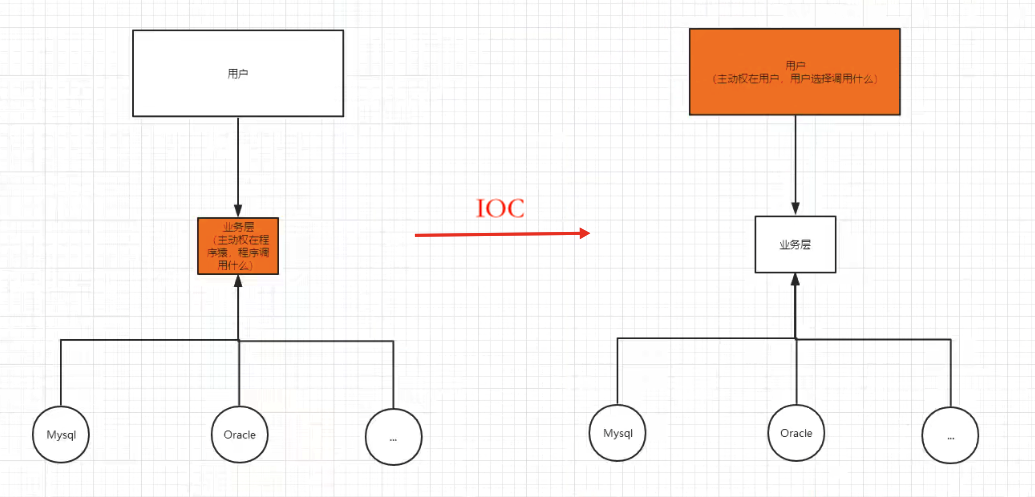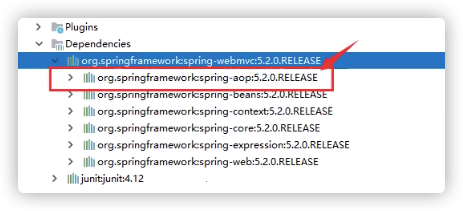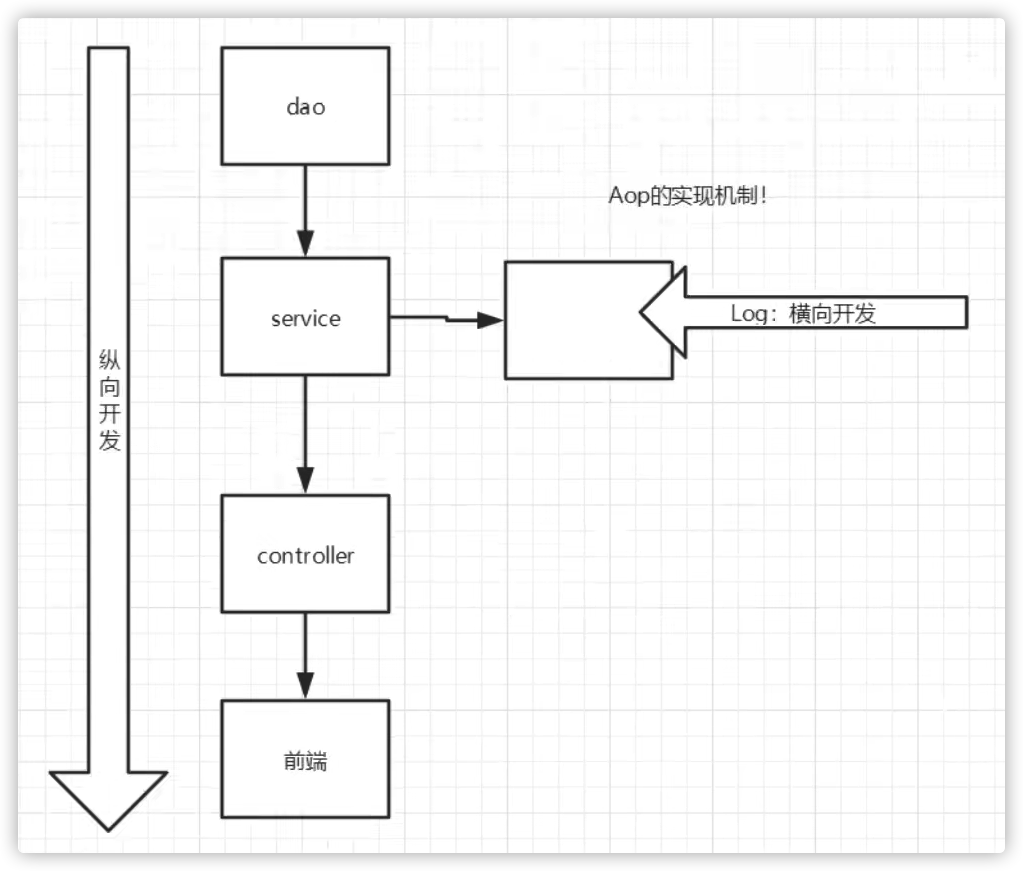Spring
Spring
Spring简介
Spring是一个轻量级的控制反转(IOC)和面向切面编程(AOP)的框架
Spring组成
- Spring Boot
- 一个快速开发的脚手架。
- 基于SpringBoot可以快速开发单个微服务。
- SpringCloud
- SpringCloud基于SpringBoot实现的。
现在大多数公司都在使用SpringBoot进行快速开发,学习SpringBoot的前提,需要完全掌握Spring及SpringMVC。
IOC
IOC理论
控制反转 IOC 是一种设计思想,个人认为所谓控制反转就是获取依赖对象的方式反转了。
控制:谁来控制对象的创建。传统的应用程序是由程序本身控制创建的,使用Spring后,对象是由Spring来创建的。
反转:程序本身不创建对象,而变成被动的接收对象。
比如通过set接口使得程序不再具有主动性,而是变成了被动的接受对象。控制器不再是在程序猿手上,而是在用户手上,程序猿不用在去管理对象的创建了,系统的耦合性大大降低~
1 | private UserDao userDao; |

解耦过程:

IOC本质
控制反转是一种通过描述(XML或注解)并通过第三方去生产或获取特定对象的方式。在Spring中实现控制反转的是IOC容器,其实现方法是依赖注入(Dependency Injection,DI)。依赖注入:就是利用set方法来实现注入的。
1 | <!--使用Spring来创建对象,在Spring中对象成为Bean--> |
使用Spring容器获取对象:
1 | //获取Spring的上下文对象 |
IOC创建对象的方式
使用无参构造创建对象,默认!
使用有参构造创建对象(假设构造方法含有一个参数)
下标赋值
下标赋值 1
2
3<bean id="user" class="com.lvjie.pojo.User">
<constructor-arg index="0" value="lvjie"/>
</bean>类型(不推荐,可能类型重复)
类型 1
2
3<bean id="user" class="com.lvjie.pojo.User">
<constructor-arg type="java.lan.String" value="lvjie"/>
</bean>参数名
参数名 1
2
3<bean id="user" class="com.lvjie.pojo.User">
<constructor-arg name="name" value="lvjie"/>
</bean>
Spring配置
导入jar包
1 | <!-- https://mvnrepository.com/artifact/org.springframework/spring-webmvc --> |
别名
alis可以给bean取一对一别名,name可以bean取多个名字
import
import一般用于团队开发使用,可以将多个配置文件导入合并为一个总的,使用的时候直接使用总的配置就可以了。
依赖注入(DI)
构造器注入
Set注入【重点】
依赖注入本质是Set注入,包括有:
bean | ref | list | set | map | props | value
p/c命名空间注入
1 | <!--需要线引入第三方约束--> |
1 | <!--p命名空间注入可以直接注入属性的值--> |
bean的作用域

单例模式(Spring默认模式):每次从容器中get的对象是同一个。
单例模式 1
<bean id="user" class="com.lvjie.pojo.User" scope="singleton"/>
原型模式:每次从容器中get的时候,都会产生一个新对象。
原型模式 1
<bean id="user" class="com.lvjie.pojo.User" scope="prototype"/>
其余的request、session、application、这些只能在 web开发中使用到。
Bean的自动装配
自动装配是Spring满足bean依赖的一种方式,Spring会在上下文中自动寻找,并给bean装配属性。在Spring中有三种装配的方式:
- 在xml中显示的配置
- 在Java中显示的配置
- 隐式的自动装配bean【重要】
byName/byType自动装配
1 | <!--byName: 会自动在容器上下文中查找,和自己对象set方法里面的值对应的beanid!--> |
1 | <!--byType: 会自动在容器上下文中查找,和自己对象属性类型相同的bean!--> |
小结:byName的时候,需要保证所有的bean的id唯一,并且这个bean需要和自动注入的属性的set方法里面的值一致。byType的时候,需要保证所有的bean的class唯一,并且这个bean需要和自动注入的属性的类型一致。
使用注解自动装配
要使用注解需要:导入约束(context)、配置注解的支持(context:annotati on-config)、在对象属性前或set方法前加入@Autowired。
1 |
|
1 | public class People { |
注解是用反射来实现的。使用Autowired我们可以不用编写Set方法了。
- @Autowired默认通过byType方式实现,而且必须要求这个对象存在。【常用】
- 如果Autowired不唯一自动装配属性(当有多个对象时),则需要通过@Qualifier(value=“xxx”)
- @Resource默认通过byName方式实现,如果找不到名字,则通过byType实现。如果两个都找不到的情况下就报错。
- @Autowired(required = false) 字段标记了注解说明这个对象可以为null。@Nullable 字段标记这个字段可以为null。
使用注解开发
bean
要使用注解开发,必须要保证aop的包导入了
使用注解需要导入context约束,增加注解的支持。
1 |
|
@Component注解等价于<bean id="user" class="com.lvjie.pojo.Uer"/>
属性注入
@Value("lvjie")注解相当于<property name="name" value="lvjie"/>
1 |
|
衍生注解
@Component 有几个衍生注解:但功能都相当于@Component,都代表将某个类注册到Spring中,对应分层对应注解名称使用。
- dao层注解【@Repository】
- service层注解【@Service】
- controller层注解 【@Controller】
作用域
@Scope("xxx")注解使用在类前相当于bean的作用域。
小结
xml 适用于任何场合,维护简单方便。注解 不是自己的类不能使用。
xml 与注解 最佳实践:
- xml用来管理bean
- 注解只负责完成属性的注入
使用Java的方式配置Spring
1 | //这里这个注解的意思,就是说明这个类被Spring接管了,注册到了容器中 |
1 | package com.lvjie.config; |
1 | public class MyTest { |
这种纯Java的配置方式,在SpringBoot中随处可见!
代理模式
静态代理

代理模式的好处:
- 可以使真实角色的操作更加纯粹,不用取关注一些公共的业务
- 公共业务就交给代理角色,实现了业务的分工
- 公共业务发生扩展时,方便集中管理
缺点:
- 一个真实角色就会产生一个代理角色,代码量会翻倍,开发效率会变低~
动态代理可以解决以上缺点。
动态代理
- 动态代理和静态代理角色一样
- 动态代理的代理类是动态生成的,不是我们直接写好的
- 动态代理分为两大类:基于接口的动态代理和基于类的动态代理
- 基于接口 ——— JDK动态代理
- 基于类 ——— cglib
- Java字节码实现 ——— javasist
需要了解两个类:Proxy:代理;InvocationHandler:调用处理程序。
1 | //等我们会用这个类,自动生成代理类! |
1 | public class Client { |
动态代理的好处:
- 可以使真实角色的操作更加纯粹,不用取关注一些公共的业务
- 公共业务就交给代理角色,实现了业务的分工
- 公共业务发生扩展时,方便集中管理
- 一个动态代理类代理的是一个接口,一般就是对应的一类业务
- 一个动态代理类可以代理多个类,只要是实现了同一个接口即可
AOP
AOP简介
AOP(Aspect Oriented Programming):面向切面编程。底层是动态代理。利用AOP可以对业务逻辑的各个部分进行隔离,从而使得业务逻辑各部分之间的耦合度降低,提高程序的可重用性,同时提高了开发的效率。
AOP在Spring中的作用
==提供声明式事务:允许用户自定义切面==
使用Spring实现AOP
使用Spring API接口
使用AOP,需要导入一个依赖包
1 | <!-- https://mvnrepository.com/artifact/org.aspectj/aspectjweaver --> |
1 | public class Log implements MethodBeforeAdvice { |
1 | public class AfterLog implements AfterReturningAdvice { |
1 |
|
1 | public class MyTest { |
自定义类
1 | <!--方式二:自定义类--> |
使用注解实现
1 | <!--方式三--> |
1 | //标注这个类是一 个切面 |
整合Mybatis
Mybatis-spring
编写数据源
sqlSessionFactory
sqlSessionTemplate
需要给接口加实现类
将自己写的实现类注入到Spring中
测试
MyTest 1
2
3
4
5
6
7
8public class MyTest {
public void test() throws IOException {
ApplicationContext context = new ClassPathXmlApplicationContext("applicationContext.xml");
UserMapper userMapper = context.getBean("userMapper", UserMapper .class);
for(User user : userMapper.selectUser()) {
System.out.println(user);
}spring-dao.xml 1
2
3
4
5
6
7
8
9
10
11
12
13
14
15
16
17
18
19
20
21
22
23
24
25<!--DataSource: 使用Spring的数据源替换Mybatis的配置
我们这里使用Spring提供的JDBC:org.springframework.jdbc.datasource
-->
<bean id="dataSource" class="org.springframework.jdbc.datasource.DriverManagerDataSource">
<property name="driverClassName" value="com.mysql.jdbc.Driver"/>
<property name="url" value="jdbc:mysql://localhost:3306/mybatis?useSSL=true&useUnicode=true&characterEncoding=UTF-8"/>
<property name="username" value="root"/>
<property name="password" value="123456"/>
</bean>
<!--sqLSessionFactory-->
<bean id="sqlSessionFactory" class="org.mybatis.spring.SqlSessionFactoryBean">
<property name="dataSource" ref="dataSource" />
<!--绑定Mabatis配置文件-->
<property name="configuration" value="classpath:mybatis-config.xml"/>
<property name="mapperLocations" value="classpath:com/lvjie/mapper/*.xml"/>
</bean>
<!--SqLSessionTemplate: 就是我们使用的sqlSession-->
<bean id="sqlSession" class="org.mybatis.spring.SqlSessionTemplate">
<!-- 只能使用构造器注入SessionFactory, 因为它没有set方法-->
<constructor-arg index="0" ref=" sqlSessionFactory"/>
</bean>
<bean id="userMapper" class="com.lvjie.mapper.UserMapperImpl">
<property name="sqlSession" ref="sqlSession"/>
</bean>UserMapperImpl 1
2
3
4
5
6
7
8
9
10
11
12public class UserMapperImpl implements UserMapper {
//在原来我们的所有操作,都使用sqlSession来执行,现在都使sqlSessionTemplate;
private SqlSessionTemplate sqlSession;
public void setSqlSession(SqlSessionTemplate sqlSession) {
this.sqlSession = sqlSession;
}
public List<User> selectUser() {
UserMapper mapper = sqlSession.getMapper(UserMapper.class);
return mapper.selectUser();
}
}
声明式事务
事务
- 把一组业务当成一个业务来做;要么都成功,要么都失败!
- 确保完整性和一致性;
事务ACID原则:
- 原子性
- 一致性
- 隔离性
- 多个业务可能操作同一个资源,防止数据损坏
- 持久性
- 事务一旦提交,无论系统发生什么问题,结果都不会再被影响,被持久化的写到存储器中!
Spring中的事务管理
1 | <!--配置声明式事务--> |
Spring
1.absolute和relative定位
2.display:table-cell在布局上的应用
3.两列布局css
4.解决GitHub访问不了问题
5.Collection集合和Map集合
6.JDK,JRE和JVM







